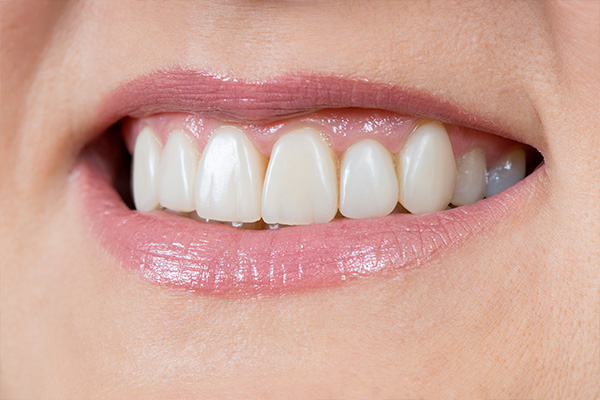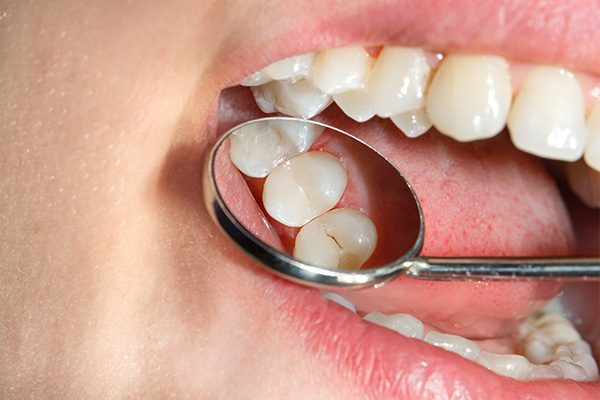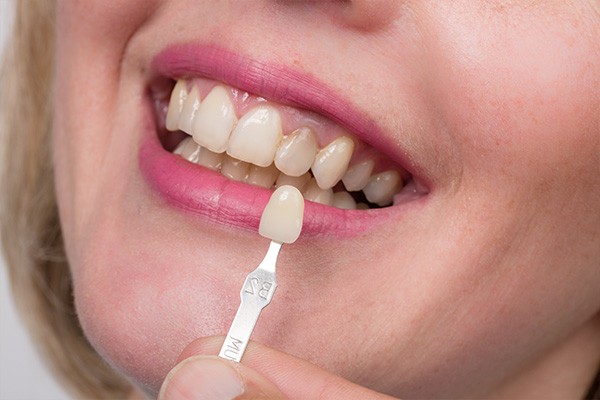Restorative Dentistry San Francisco, CA
Restore your mouth to its full form and function.
When a tooth is lost, nothing is ever the same. The entire balance of a healthy mouth is lost: the bite goes off, opposing teeth overgrow in unpredictable directions, facial appearance ages.
Restorative dentistry is all about bringing mouths back into use. How? Some of the restorative procedures are:
Cavity Fillings
Protect your teeth against further decay.
When cavities from decay begin to form in your teeth it is important that they are treated with fillings as soon as possible. Untreated cavities compromise the strength of your teeth, making chips and severe breaks much more likely. Additionally, since the surface of the tooth has been penetrated by decay, cavities can lead to severe infections to the interior of your tooth, which eventually may lead to a root canal. There are several options available for treating cavities, including:
Composite Fillings
One option to treat a cavity is a composite resin filling. This method is preferred by many because the color of the filling can be matched to the natural shade of the tooth, making them less visible. They provide significant strength to the restoration. At one time it was thought they were best used on small to mid-sized cavities that endure moderate chewing pressure. But today there are new composite materials that provide strong reliable restorative qualities even on molars. Also, there is less drilling required so more of the natural tooth can be preserved.
Amalgam Fillings
The most traditional, proven method for treating a cavity is by using an amalgam (silver-mercury based) filling. Although there have been some health concerns due to the toxicity of mercury there has been no conclusive evidence that amalgams pose any threat when used in dentistry. Today they continue to be popular for durability and they are the best choice for larger cavities that must endure the stresses of heavy chewing.
Ionomer Fillings
Ionomer fillings are made from glass particles mixed with acrylic acids. They are tooth-colored to match your natural teeth. Ionomer fillings are fragile, which is why they are only implemented on very small cavities or on tooth roots.
Crowns
Crowns are used to help restore your teeth and mouth.
A crown is a dental restoration that covers, or “caps” a tooth to restore it to its normal shape and size. A crown can strengthen a tooth that has had numerous fillings, is cracked or has broken. Sometimes a crown is the best solution to improve the appearance of a tooth.
How is a crown placed?
To prepare the tooth for a crown, it is prepared so the crown can fit over it. An impression of teeth and gums is made and sent off to the laboratory for crown fabrication. A temporary crown is fitted over the tooth until the new replacement crown is made. At a second visit, the temporary crown is removed then the new crown is fitted onto the tooth and cemented.
Will the crown look natural?
Yes. A crown that looks like a natural tooth is the goal. To achieve a natural look, a number of factors are considered: the color, bite, shape, and length of natural teeth. Anyone of these factors alone can affect the appearance.
If you have a certain cosmetic look in mind for your crown, discuss it with us at your initial visit. When the procedure is complete, your teeth will not only be stronger, but they may be more attractive.
Why crowns and not porcelain veneers?
Crowns require more tooth structure removal as they cover more of the whole tooth than porcelain veneers. Crowns are customarily indicated for teeth that have sustained significant loss of structure. Crowns may be placed on natural teeth or on dental implants.
How should I take care of my crowns?
To prevent damaging or fracturing the crowns, avoid chewing hard foods, ice or other hard objects. Tooth grinding can be a consideration as to what material the crown is made. Besides visiting your dentist and brushing twice a day, cleaning between your teeth is vital with crowns. Floss or other dental cleaners (specially shaped brushes or picks) are important tools to remove plaque from the crown area where the gum meets the tooth. Plaque in that area can cause dental decay and gum disease at the base of the crown.
Dental Implants
A permanent solution for missing one or more teeth.
Once teeth are missing from the jawbone—whether one or many; whether from accident or disease—something very important is missing as well. That’s tooth stability, and that’s because once one or more teeth are removed, the jawbone that previously anchored the roots begins to dissolve. Dental researchers worked for years to find ways to keep bone from shrinking. Now we’re proud to offer a solution that prevents bone loss while permitting durable, fixed, permanent restorations.
They’re dental implants. And they’re the next best tooth replacement option to the real thing because they’re rooted in the bone just like your original teeth. The procedure involves setting one or more implant anchors into the jawbone. These roots, made of titanium, are strong, non-toxic, and biologically compatible with the mouth.
The key to a successful implant is something we call osseointegration: the bone actually grows into the implant itself. Once this bond stabilizes we cap the root with a natural-appearing replacement tooth. Or multiple replacement teeth. Or use it as an anchor to support a crown or bridge—even a denture! Implants aren’t right for everyone. You need sufficient bone in your jaw to support them and a willingness to take good care of yourself during treatment.
But the benefits of implants, from restored chewing and speaking efficiency to improved nutrition, are undeniable.
What can dental implants do?
- Replace one or more teeth without affecting bordering teeth.
- Support a bridge and eliminate the need for a partial denture.
- Provide support for a denture, making it more secure and comfortable.
All Restorative Services
Inlays & Onlays
Treat severe cavities on the rear teeth.
Inlays or Onlays are typically used when cavities on the chewing surface of back teeth have become too severe to be treated with traditional fillings. The difference between an onlay and inlay is determined by the positioning of the damage in regards to the chewing surface of the tooth. If the damage is restricted to within the depression surface of the tooth (within the cusps) it is an inlay. If more extensive damage has progressed and the cusps must be recreated, it becomes an onlay.
Inlays and onlays can be created using gold, porcelain, or a composite resin colored to match your natural tooth. The latter two options are the most popular today due to their aesthetic appearance, but gold is still one of the strongest options. These restorations are a two-step process. First, the tooth is prepared by removing decay or old materials then an impression is taken of the affected area. The impression molds are sent to a dental laboratory where a skilled technician fabricates the restoration. At the next appointment, the inlay or onlay is cemented into place.
Bridges
Used to replace one or more missing teeth.
A bridge is a dental appliance that replaces one or more natural missing teeth, thereby “bridging” the space between two teeth. Fixed bridges are cemented into place next to the “abutment” teeth–the surrounding teeth on either side of the space, or “span.” Unlike removable partial dentures, bridges are not removable.
Who should get a bridge?
If you are missing any teeth and are committed to maintaining good oral hygiene practices, you may be a good candidate for a bridge. A bridge is the most natural choice to fill the space in your mouth left by missing teeth. If left unfilled, this space can cause the surrounding teeth to drift out of position and can cause teeth and gums to become more susceptible to tooth decay and gum disease, causing further tooth loss. Bridges not only correct an altered bite and improve your chewing ability and speech, but they also safeguard your appearance by preventing the collapse of your facial features that can cause premature wrinkles and age lines.
What type of bridges are there?
Besides traditional bridges, another popular design is the resin bonded or “Maryland” bridge, primarily used for the front teeth. This is usually the most economical choice when the abutment teeth are healthy and don’t contain large fillings. The replacement tooth is fused to metal bands that can be bonded to the abutment teeth with resin cement and hidden from view, reducing the amount of preparation on the adjacent teeth.
A cantilever bridge may be used if there are teeth on only one side of the span. This involves anchoring the false tooth to one side over one or more natural, adjacent teeth. If there are no adjacent teeth to act as anchors, we may recommend an implant–a metal post that is surgically embedded into the bone and capped with a crown as an abutment. In some cases where the span is large, we may recommend a removable partial denture or even an implant-supported prosthesis.
What procedures are involved?
For a traditional fixed bridge, the first appointment consists of reducing the adjacent abutment teeth that will act as anchors. Impressions are made, from which a metal framework, including the replacement tooth, is created. By the second appointment, the final bridge is fitted over the teeth.
The total treatment time is usually between two or four weeks, depending on the type of bridge.
How do I care for a bridge?
With a bridge, it is more important than ever to brush, floss, and see your dentist regularly. If you do not control the buildup of food debris and plaque–the sticky film of bacteria formed from food acids–your teeth and gums can become infected, requiring further treatment and resulting in possible loss of the bridge. You may also use floss threaders that help remove bacteria from hard to reach spaces between the bridge and adjacent teeth and gums.
If you maintain optimal oral hygiene care, you can expect your fixed bridge to last as many as 8-10 years, or even longer.
Bone Grafting
A weakened bone might need to be strengthened using a bone graft.
An oral bone graft is usually required when significant gum recession has taken place exposing root surface. Sometimes gum tissue recedes the bone beneath it experiences resorption (degeneration) which compromises the basic strength of the teeth in the jaw.
To perform the bone graft the gums in the affected area are first exposed revealing the receding bone. Then a small piece of bone is taken from another area of the body (preferably the back of the jaw or chin) and attached to the affected area with titanium screws. The new bone provides increased structural support for restorations, prevention of further bone resorption, and overall increased strength of the jaw bone.
Extractions
Remove infected, decayed or unnecessary teeth
You might think extracting a tooth goes against the goal of a restorative procedure, and it’s true that it is somewhat counterintuitive to remove a tooth in order to restore function. Our dental office is committed to doing everything possible to save a natural tooth, but in some cases, it is in the best interest of the patient to completely remove it. Examples of such instances are tooth decay that has progressed too far to reverse or in preparation for dentures, dental implants, or orthodontic treatment.
When a dental extraction is the only alternative, the patient is mildly sedated and the tooth is gently rocked out to release it. In some cases our office will recommend an oral surgeon to remove the tooth.
Dentures
Replace your missing teeth with a dental prosthetic.
In a perfect world, there would be no dental decay. There would be no gum disease, no cracked molars, no knocked out incisors.
It’s not a perfect world. Teeth, the hardest, most durable organs of the human body, are also those most subject to bacteria and trauma. Yet at the same time, teeth are among the most difficult parts of the body to heal.
There are, it seems, no substitutes for teeth. However, science has developed some very useful substitutes for no teeth.
Full or partial dentures are appliances, usually removable, that fit over the gums and hold artificial teeth in spaces where natural teeth are missing. Everyone has heard of dentures, but it tends to be of those subjects where so much information is passed around and so little is really understood. For example, popular wisdom has it that only the first set of dentures fit properly. That’s only partially true. They tend to feel best because the gum ridges have not yet receded. But we can now re-fit new dentures that look and feel just as good as the original.
In fact, the denture fit depends largely on the health of the gums. That’s why we recommend you see us at least once a year for a denture check-up. Denture adhesives are a band-aid solution at best, and we know our office can do better with proper custom-fitted dentures.
And no, overuse of your denture doesn’t cause it to wobble. That’s a result of changes in the mouth, largely the natural shrinkage of gum tissue and bone. Again—we can help!
Implant Dentures
The best solution for those with loose or poor-fitting dentures.
Any denture wearer will tell you there’s nothing more upsetting than a slipping denture and the anxious uncertainty it brings. Not only can the denture become an embarrassment, but an ill-fitting appliance will eventually wear down the very ridges (bone) that support it. Then it’s more slipping, more often.
One solution to this uncomfortable state of affairs is dental implants. You’ve heard of implants that replace a single tooth, or several at either end of a traditional bridge. Well, the denture wearer can benefit as well. With two to four implants in place—bonded to the bone itself—a denture has something to “hang on” to. We create an over-denture that fits atop the implants and lends more permanent stability.
Next-to-natural options that restore more than missing teeth.
The stability provided by implant dentures is as close as you can get to natural teeth, but improved chewing and speaking efficiency are by no means where the benefits end. By putting teeth back where they belong, dentures and implants can restore and keep facial muscles from sagging by providing support for the cheek and lips. And denture wearers may also notice improved nutrition since they can finally enjoy those crunchy fresh fruits and vegetables. It can truly be a life-changing experience, so please contact our office if you think you may be a candidate for implant-retained dentures.



